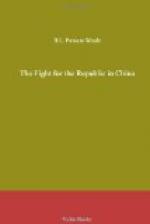China as adversely as Japan, and therefore should
be universally understood. Japanese history,
if stripped of its superficial aspects, has a certain
remarkable quality; it seems steeped in heroic blood.
The doctrine of force, which expresses itself in its
crudest forms in Europe, has always been in Japan a
system of heroic-action so fascinating to humanity
at large that until recent times its international
significance has not been realized. The feudal
organization of Japanese society which arose as a
result of the armed conquest of the islands fifteen
hundred years ago, precluded centralizating measures
being taken because the Throne, relying on the virtues
of Divine Ancestors rather than on any well-articulated
political theory, was weak in all except certain quasi-sacerdotal
qualities, and forced to rely on great chieftains
for the execution of its mandates as well as for its
defence. The military title of “barbarian-conquering
general,” which was first conferred on a great
clan leader eight centuries ago, was a natural enough
development when we remember that the autochthonous
races were even then not yet pushed out of the main
island, and were still battling with the advancing
tide of Japanese civilization which was itself composed
of several rival streams coming from the Asiatic mainland
and from the Malayan archipelagoes. This armed
settlement saturates Japanese history and is responsible
for the unending local wars and the glorification
of the warrior. The conception of triumphant
generalship which Hideyoshi attempted unsuccessfully
to carry into Korea in the Sixteenth Century, led
directly at the beginning of the Seventeenth Century
to the formal establishment of the Shogunate, that
military dictatorship being the result of the backwash
of the Korean adventure, and the greatest proof of
the disturbance which it had brought in Japanese society.
The persistence of this hereditary military dictatorship
for more than two and a half centuries is a remarkable
illustration of the fact that as in China so in Japan
the theocratic conception was unworkable save in primitive
times—civilization demanding organization
rather than precepts and refusing to bow its head to
speechless kings. Although the Restoration of
1868 nominally gave back to the Throne all it had
been forced to leave in other hands since 1603, that
transfer of power was imaginary rather than real,
the new military organization which succeeded the Shogun’s
government being the vital portion of the Restoration.
In other words, it was the leaders of Japan’s
conscript armies who inherited the real power, a fact
made amply evident by the crushing of the Satsuma
Rebellion by these new corps whose organization allowed
them to overthrow the proudest and most valourous
of the Samurai and incidentally to proclaim the triumph
of modern fire-arms.




